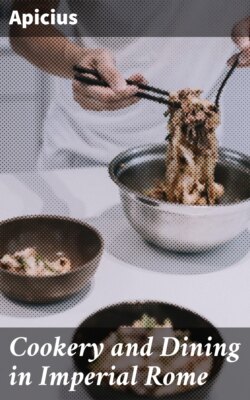Читать книгу Cookery and Dining in Imperial Rome - Apicius - Страница 27
На сайте Литреса книга снята с продажи.
Modern Research
ОглавлениеTable of Contents
Modern means of communication and photography have enabled scientists in widely different parts to study our book from all angles, to scrutinize the earliest records, the Vatican and the New York manuscripts and the codex Salmasianus in Paris.
Friedrich Vollmer, of Munich, in his Studien (cit. Apiciana) has treated the manuscripts exhaustively, carrying to completion the research begun by Schuch, Traube, Ihm, Studemund, Giarratano and others with Brandt, his pupil, carrying on the work of Vollmer. More modern scientists deeply interested in the origin of our book! None doubting its genuineness.
Vollmer is of the opinion that there reposed in the monastery of Fulda, Germany, an Archetypus which in the ninth century was copied twice: once in a Turonian hand—the manuscript now kept in the Vatican—the other copy written partly in insular, partly in Carolingian minuscle—the Cheltenham codex, now in New York. The common source at Fulda of these two manuscripts has been established by Traube. There is another testimony pointing to Fulda as the oldest known source. Pope Nicholas V commissioned Enoche of Ascoli to acquire old manuscripts in Germany. Enoche used as a guide a list of works based upon observations by Poggio in Germany in 1417, listing the Apicius of Fulda. Enoche acquired the Fulda Apicius. He died in October or November, 1457. On December 10th of that year, so we know, Giovanni de’Medici requested Stefano de’Nardini, Governor of Ancona, to procure for him from Enoche’s estate either in copy or in the original the book, entitled, Appicius de re quoquinaria (cf. No. 3, Apiciana). It is interesting to note that one of the Milanese editions of 1498 bears a title in this particular spelling. Enoche during his life time had lent the book to Giovanni Aurispa.
It stands to reason that Poggio, in 1417, viewed at Fulda the Archetypus of our Apicius, father of the Vatican and the New York manuscripts, then already mutilated and wanting books IX and X. Six hundred years before the arrival of Poggio the Fulda book was no longer complete. Already in the ninth century its title page had been damaged which is proven by the title page of the Vatican copy which reads:
INCP
API
CÆ
That’s all! The New York copy, it has been noted, has no title page. This book commences in the middle of the list of chapters; the first part of them and the title page are gone. We recall that the New York manuscript was originally bound up with another manuscript, also in the Phillipps library at Cheltenham. The missing page or pages were probably lost in separating the two manuscripts. It is possible that Enoche carried with him to Italy one of the ancient copies, very likely the present New York copy, then already without a title. At any rate, not more than twenty-five years after his book hunting expedition we find both copies in Italy. It is strange, furthermore, that neither of these two ancient copies were used by the fifteenth century copyists to make the various copies distributed by them, but that an inferior copy of the Vatican Ms. became the vulgata—the progenitor of this series of medieval copies. One must bear in mind how assiduously medieval scribes copied everything that appeared to be of any importance to them, and how each new copy by virtue of human fallibility or self-sufficiency must have suffered in the making, and it is only by very careful comparison of the various manuscripts that the original text may be rehabilitated.
This, to a large extent, Vollmer and Giarratano have accomplished. Vollmer, too, rejects the idea invented by the humanists, that Apicius had a collaborator, editor or commentator in the person of Cœlius or Cælius. This name, so Vollmer claims, has been added to the book by medieval scholars without any reason except conjecture for such action. They have been misled by the mutilated title: Api … Cæ … ; Vollmer reconstructs this title as follows:
API[cii artis magiri- (or) opsartyti-]
CÆ[libri X]
Remember, it is the title page only that is thus mutilated. The ten books or chapters bear the full name of Apicius, never at any time does the name of Cœlius appear in the text, or at the head of the chapters.
The Archetypus, with the book and the chapters carefully indexed and numbered as they were, with each article neatly titled, the captions and capital letters rubricated—heightened by red color, and with its proper spacing of the articles and chapters must once have been a representative example of the art of book making as it flourished towards the end of the period that sealed the fate of the Roman empire, when books of a technical nature, law books, almanacs, army lists had been developed to a high point of perfection. Luxurious finish, elaborate illumination point to the fact that our book (the Vatican copy) was intended for the use in some aristocratic household.
